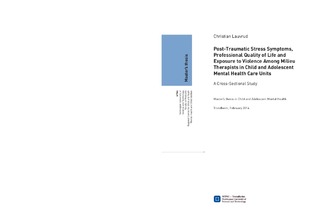| dc.description.abstract | Background: The level of aggression in child and adolescent mental health care (CAMH) can be high, leading to adverse feelings and negative workplace experiences among caregivers. If this then leads to burn-out and posttraumatic stress, it could interfere with the caregivers’ therapeutic relationships and alliances which are known to be imperative for results in CAMH care. Various CAMH units organise themselves in different ways in order to optimize therapeutic relations. Therefore it could be hypothesized that there are differences between institutions with regard to professional quality of life and adverse reactions when exposed to aggression.
Objective: to explore the differences between professional quality of life, symptoms of post-traumatic stress and exposure to violence among milieu therapists in two differently organised CAMH units.
Methods: The study was cross-sectional using two questionnaires: the Post Traumatic Check List – Civilian version (PCL-C) and Professional Quality of Life Scale (ProQoL). The survey was administered anonymously among milieu therapists at two CAMH units. Correlation and linear regression methods were applied to explain differences.
Results: There were significant differences between the two institutions. In the institution with high exposure to violence, burnout scores and symptoms of posttraumatic stress were significantly lower than in the institution with low exposure to violence. These differences were not explained for by differences in sex, age, length of professional experience and exposure to violence on the two institutions.
Conclusion: There are differences in burnout and posttraumatic stress symptoms between the two institutions which are not explained for by the level of exposure to violence. It is concluded that other factors must be of importance to explaining the differences. It is speculated that the staffs’ amount of continuous face-to face contact with users of the facilities and differences in user characteristics could induce this high symptom load. | nb_NO |
